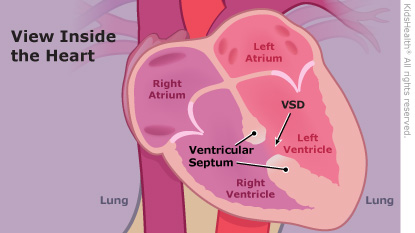Ventricular Septal Defect: How to Care for Your Child
Your child has a heart defect called a VSD (ventricular septal defect). The heart has four chambers. The lower chambers are the right ventricle and left ventricle. They're divided by a wall of tissue called the ventricular septum. A VSD is a hole in this wall. The hole lets blood move from the left ventricle into the right ventricle, causing extra blood to go to the lungs. The blood flowing through the hole makes an extra noise, known as a heart murmur. Health care providers can hear a heart murmur when listening to the heart with a stethoscope.
A small hole usually does not cause symptoms and doesn't need treatment. Larger VSDs let too much blood flow to the lungs, putting stress on both the heart and the lungs. Larger VSDs usually need surgery to close them.


In infants:
-
fast breathing
-
fast heart rate
-
trouble feeding
-
not gaining weight
In older children:


You notice that:
-
The skin between your child's ribs is sucking in during breathing.
-
Your child has trouble feeding and seems dehydrated. Signs include dizziness, drowsiness, a dry or sticky mouth, sunken eyes, crying with few or no tears, or peeing less often (or having fewer wet diapers).

How is a VSD diagnosed? A VSD can be diagnosed at any age. Health care providers might notice a murmur in babies or young children when they listen to the heart. Then, they usually order an echocardiogram or "echo." This painless ultrasound test takes pictures of the heart.
Sometimes older children with a VSD may need a heart catheterization. During a catheterization, a thin, soft plastic tube (a catheter) is put into a blood vessel in the arm or leg, then threaded to the heart. The catheter takes measurements and pictures to help the cardiologist better understand what's going on in the heart.
How is a VSD treated? If the VSD needs to be fixed, this can be done by catheterization or surgery:
-
Catheterization, in this case, is used to carry a small device to the heart to plug the hole. Over time, the heart tissue grows around the device, holding it in place.
-
In surgery, the surgeon puts a patch over the hole. The surgeon chooses the best type of patch during surgery. Sometimes surgery needs to happen soon after the VSD is found. Other times, it can be done in a few months.